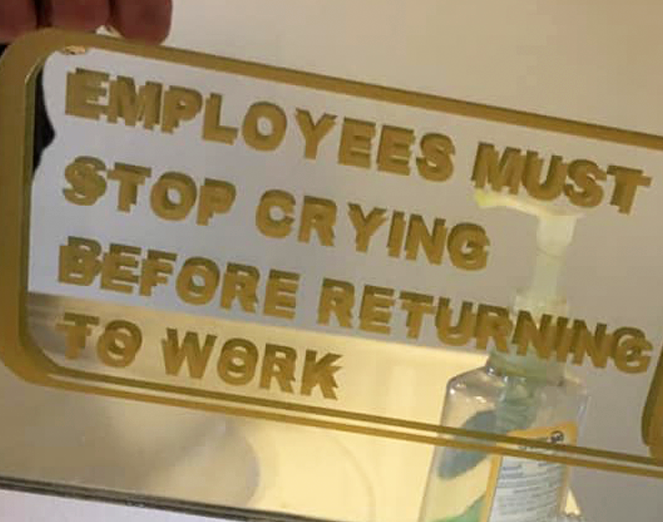The cost of living in desirable locations can only be described as unsustainable. I’m only able to swing it because I’m on a software engineer salary.
Same spot here. Took my permanent remote SE job to a depressed but beautiful coastal California town. A lot of folks seem to dislike me for some reason.
most people living there are mostly into programming tech/ in norcal, or unless your high paid nurse, doctor, or engineer, or an executive. the college students ar eliving with roomates here.
I really don’t understand how you can earn $150,000 a year and can’t make ends meet without making some really irresponsible decisions, though. My family of four is living off $40,000 (CAD) and all our bills are paid. I’d blame it on Americas lack of social programs but Canadians making $200,000+ a year are saying the same thing.
- college debt
- car debt (public transit has been actively dismantled by oil and car lobby in past 100 years) forcing most people to have to go into hock for a car.
- medical debt because think of the profits
- educational debt - public education that could lead to a populace making better decisions about finance has been deliberately and now almost completely destroyed. We’re going to put crosses in schools but definitely remove math requirements for HS diplomas.
- predatory, colluding landlord practices combined with corporate funds now accounting for 30+% of all residential real estate purchases. Accelerates affordability crisis and related issues
That’s just the starter pack for the US.
Congrats on living in what is likely a low COL area, but many are concentrated in HCOL areas in the US and elsewhere. Look at Vancouver BC and Toronto, same deal in Canada. US has that as well combined with above.
Straight up no idea how you’re doing that - genuinely you should be proud of your budgeting.
My partner and I live quite comfortably admittedly, but we rarely buy “things” - our biggest discretionary spending by far is on higher quality food. Our net expenses last year was around 65k CAD.
24k went to housing, around 20k went into investments and savings, and the last 20k was on “everything else”, including discretionary spending. We live comfortably but not nearly extravagantly and our expenses floor for the two of us is probably 40k… let alone adding two kids.
And we live in an incredibly cheap city compared to Vancouver/Toronto!
Take the 20k out of investments and savings and you have your answer for how they are doing it.
… 65 - 20 = 45, which I explicitly called out as our lowest expenses for 2 people but their comment is about 40 for a family of four…
Off by a factor of 2, bud
Yeah bud and my point is they aren’t saving. Theres things they need to be doing that they aren’t that doesnt necessarily effect their month-to-month lives but will effect them in an emergency, or in retirement (lol)
Which isn’t really relevant to their original comment about basic necessities? So far it’s like you haven’t bothered to read any comments but just really wanted to say something. Got the number of people for my expenses comment wrong, completely missed the point of the main comment. 0/2.
Its extremely relevant. You take away all you put toward savings and now you are at their level of income + expenses? No idea how you aren’t seeing that. They then buy cheaper produce/food to compensate for the added family members and probably skip on all clothing/entertainment for the adults. You see it now Mr Krabs?
In HCOL areas, 150k/yr can be barely above poverty level. (See SF as an example, poverty income for a single earner is ~118k USD)
Given the number of those kind of areas, and the cost of rent now, it makes perfect sense.
It is very difficult to do. You really do have to be over-leveraged and bad with money. Which is probably why 99.966% of households making 150k+ are showing up as not delinquent on loans in these data.
We live off way less then that. And bills are getting paid. I want to see what they’re spending their money on.
Studios going for $3,400 in my area. Los Angeles
Yikes! I pay 591 a month on my mortgage.
LA is pretty expensive, the closer you are too hollywood?
some are low as 2000/month, studio in bay area, but its pretty uncommon, i know a co-worker that has one.
I imagine a lot of people making that much did exactly what I did. Over-leverage but temporarily. House poor basically.
When COVID hit I was renting in the bay area with my girlfriend. During lockdown I proposed, and after deciding we want a family, decided to take our bay area salaries elsewhere to buy a house.
We traded our 3k rent for a 2k mortgage with 1k insurance and taxes. Even.
But, leaving the bay we needed cars. My one little two seater wasn’t going to do it, we’re starting a family. So we got two larger cars, right when the market was inflated. Financed both of them.
The new big property we got has a little barn, let’s renovate that into an ADU for guests and to generate rent. Didn’t have the cash on hand so took out another loan about the same as a car to fix that up.
Now we’re strapped, basically living month to month. But those secondary loans were all 5 year loans, so in 2 more years they’re paid off, freeing up about $3k per month.
I basically don’t think any of these articles about people making that kind of salary are taking into account how weird a time covid was. Lots of people made big changes while interes rates were low, purposely over-leveraging themselves. It also gave everyone this yolo attitude as well, like fuck it all, treat yourself.
I’d be more interested to revisit this in 2027 when any 5 or 6 year car loans and secondary loans taken out during the record low rates are all paid off.
Are the cars used? Early 2000’s Buicks with the 3.8l engine are incredibly cheap even with low miles (a really mint one is 5k, a good daily driver can be had for 2.5 to 3.5k).
They’re extremely reliable and relatively safe cars. Not bad on gas, cheap to repair, and extremely cheap insurance, since you don’t need collision, only liability.
most likely irresponsible decision: buying some expensive toys like new cars, new flagship phones, shopping eating out everyday, it adds up, getting yourself scammed. i know people who are in this income range and they do this, despite telling them the SO is spending shit ton on eating out and shopping, but one of them is a pushover, so it falls on deaf ears. if your eating out everyday it adds up, like 70-100$(restaurants)/day+gas+ shopping , not to mention yearly taxes/ monthlyutility bills. you can afford to do this if you earn like twice that much, or a million/year. but not at the low 100k/yr income.
i highly suspect its mostly eating out everyday, which can amount in the 10s of thousands per YEAR of just take out food, and restuarants. 30-40k/year on average if people are eating out.
deleted by creator
Yeah, lifestyle inflation is a a problem that so, so many people put themselves into.
They are living paycheck to paycheck, get that nice new job earning 3x as much. And instead of paying off their debt and getting into a very cosy financial space; they instantly start spending 3x as much money on stuff, and now they are suddenly living paycheck to paycheck again.
There is also a cultural lifestyle inflation that has infected society in the last 5-10 years. Everything that can be has been moved to subscription basis, and people all want to have the latest and greatest of everything. Hire a taxi for your burrito delivery and such.
It’s hard to watch people that I know are struggling financially continuously blow money on stuff like daily food delivery and $200/month cell phone plans. I’m just fortunate to have the perspective that comes with growing up before all that was “normal”
monthly cell phone plan bills pales in comparison to eating out daily. if your spending 70-100/day on eating alone that is more than any utility bill/cell phone plan combined.
Are people really spending that much on food delivery? That would be totally absurd.
In my part of the USA, a family can easily obtain take-out meals for $10 per person or less. That’s not including a taxi for the food, but picking it up yourself. Takes me about 5-10 minutes in the car to do so.
But also nobody needs a $200 phone plan. Mine is under $50/mo with unlimited data.
not food delivery but just eating out like in restaurants.+shopping as well.
Struggling with car payments, you say.
Our EU household doesn’t make $150k/y even if you’d consider the hidden supergross taxes.
I’ve never had a car loan in my life, nor anything beyond the most basic insurance.
If you can’t afford to buy a car, then you can’t afford to wreck it.
It’s better to send that extra money into my savings account or stock portfo rather than waste it on interest and extra insurance. Then I’ll at least get too see that money again some day.
Welcome to America where a car is a necessity and public transit is near zero. Average car payment is $700 now and auto insurance is $200
Yes but as a Texan. Majority of cars people drive are status symbols. I see trucks as large as military vehicles driving around like no one’s business.
So yeah… Insurance is going to be higher because of these drivers and payments are going to be high.
My 2007 Honda Accord does not have anything close to a 200$ a month insurance payment, nor I have a car payment to worry about.
You don’t need to spend $700/mo to get a car. Spending that much is a choice you are free to make, but still a choice in the end.
The average monthly car payment is $745 for new cars and $521 for used.
https://www.nerdwallet.com/article/loans/auto-loans/average-monthly-car-payment
Correct, and half of people pay below the average. You do not need to pay $700/mo for a car, many are available for much, much cheaper. If your finances can only swing $400/mo, buy a $400/mo or a $300/mo car.
But I need a 3500 series truck in case I go camping or I have to move a mattress!
Maybe, but the average car payment for people who don’t take out loans to buy cars is… Zero.
42% of Americans cannot afford a $400 emergency.
I am not sure what that has to do with what I said.
I guess it reinforces what I said? If they cant afford an emergency, why are they getting into more debt? Maybe if they didnt take out the car loans in the first place they could…
Used Buicks from the 2000’s can be had for around 3 grand and are very reliable if they have the 3.8l engine. Insurance is often less then 400 a year.
I, too, need a car. But I choose not to go down this route.
I bought my current one five years ago for $4k and spent another $2k to get it reliable. Minimum liability insurance is like $20/mo.
I’m looking to trade up in a bit for something twice as pricy, and I’ll skip the loan part then, too.
Auto insurance in the us is nuts.
But having to have a car and having to have car payments are two different things. Boggles my mind what people are willing to take loans for. Save the money and buy it, or don’t buy it at all.








